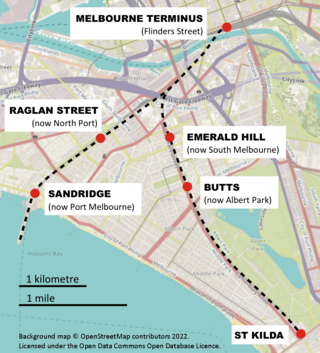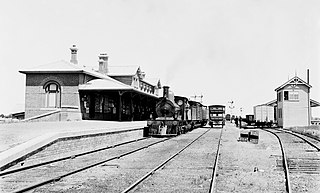Related Research Articles

The Melbourne and Hobson's Bay Railway Company was a railway company in Victoria, Australia. The company was incorporated on 20 January 1853 to build the line from Melbourne to the port of Sandridge, now Port Melbourne.

The Victorian Railways X class was a mainline goods locomotive of the 2-8-2 'Mikado' type operated by the Victorian Railways (VR) between 1929 and 1960. They were the most powerful goods locomotive on the VR, aside from the single H class, H220, which was confined to the North East line, until the advent of diesel-electric traction, and operated over the key Bendigo, Wodonga, and Gippsland mainlines.

The AA class was an express passenger locomotive that ran on the Victorian Railways between 1900 and 1932. The largest, heaviest and most powerful 4-4-0 steam locomotive to run in Australia, it was the final development of this locomotive type in Australia.

The Victorian Railways B class was a class of 2-4-0 passenger locomotives operated by the Victorian Railways (VR) between 1862 and 1917, built by various builders. The B class locomotives are regarded as the first mainline VR motive power, and were highly successful in passenger operations.
The Victorian Railways V class of 1857 was a class of 0-6-0 goods locomotives operated by the Victorian Railways between 1858 and 1904, built by George England and Co., Newcastle upon Tyne, England.

The Victorian Railways F class was originally a class of 2-4-0 light line passenger locomotives operated by the Victorian Railways between 1874 and 1929.

Melbourne and Hobson's Bay Railway Company 2-2-2WT (1854) was the first locomotive operated after the inauguration of a public railway line in Australia. It had 7+7⁄8 in (200 mm) diameter cylinders and was capable of producing 30.0 horsepower, reaching 25 mph (40 km/h) and hauling 130 tonnes.
The Victorian Railways G class was a class of 4-4-0 light line passenger locomotives operated by the Victorian Railways between 1877 and 1904.
The Victorian Railways H class was a class of 4-4-0 light line passenger locomotives operated by the Victorian Railways between 1877 and 1916.

The D class of 1887 were Phoenix-built locomotives to be used on Victorian Railways.
The D class of 1876 was the first example of American-built locomotives to be used on Victorian Railways, and among the first such engines to operate in Australia.
The Victorian Railways No. 1 was the first government passenger steam locomotive on Victorian Railways. It was a 2-2-2 passenger locomotive operated by the Victorian Railways between 1858 and 1890 and again between 1893 and 1904, built by George England and Co., Newcastle upon Tyne, England.
The Victorian Railways J class of 1859 was a class of 2-2-2 main line passenger locomotives operated by the Victorian Railways between 1860 and 1912, built by Beyer, Peacock & Company, Manchester, England.
The Victorian Railways P class was a class of 0-6-0 goods locomotives operated by the Victorian Railways between 1860 and 1921, built by Beyer, Peacock & Company, Manchester, England.
The Victorian Railways L class was a class of 2-4-0ST passenger locomotives operated by the Victorian Railways between 1861 and 1906, built by both George England and Co., Newcastle upon Tyne, England and Slaughter, Gruning & Co., Bristol, England.
The Geelong & Melbourne Railway Company operated a total of 1 locomotive that fell under the Whyte notation of 0-4-0T, with a Vertical boiler, between 1855 and 1860. Later it was operated by the Victorian Railways between 1860 and 1893. This was the second locomotive manufactured in Australia.
The Geelong and Melbourne Railway Company operated a total of four 2-2-2WT locomotives between 1856 and 1860. They were later operated by the Victorian Railways between 1860 and 1889.

The Victorian Railways O class was a class of 0-6-0 goods locomotives operated by the Victorian Railways between 1862 and 1922, built by various builders.
The Victorian Railways No. 100 was the first government built steam locomotive on Victorian Railways. It was a 2-4-0 passenger locomotive operated by the Victorian Railways between 1872 and 1916, built by Williamstown Workshops.
This was a group of 6 4-4-0WT passenger steam locomotives, built by Robert Stephenson & Company for an early private railway operator in Victoria, and expanded by another 20 locomotives locally built by Robinson Brothers and Phoenix Foundry for the Victorian Railways. They later were known as the Victorian Railways C class.
References
- Dee; et al. (1981). Power Parade. Melbourne: VicRail Public Relations Division. p. 13. ISBN 0-7241-3323-2.
- Cave, Norman; Buckland, John; Beardsell, David (2002). "Chapter 2". Steam Locomotives of the Victorian Railways. Vol. 1: The First Fifty Years. Melbourne, Vic: ARHS Victoria Division. pp. 3–17. ISBN 1876677384.
- Cave, Norman; Buckland, John; Beardsell, David (2002). "Chapter 11". Steam Locomotives of the Victorian Railways. Vol. 1: The First Fifty Years. Melbourne, Vic: ARHS Victoria Division. pp. 95–96, 102–104. ISBN 1876677384.
- Cave, Norman; Buckland, John; Beardsell, David (2002). "Chapter 17". Steam Locomotives of the Victorian Railways. Vol. 1: The First Fifty Years. Melbourne, Vic: ARHS Victoria Division. pp. 168–169, 173. ISBN 1876677384.
Specific
- 1 2 3 4 5 6 7 8 9 Victorian Railways Rolling Stock Branch: Diagrams & Particulars of Locomotives, Cars, Vans & Trucks (1904 ed.). Vic: Victorian Railways. 1904. p. 5.
- 1 2 3 4 Cave, Norman; Buckland, John; Beardsell, David (2002). Steam Locomotives of the Victorian Railways. Vol. 1: The First Fifty Years. Melbourne, Vic: ARHS Victoria Division. p. 14. ISBN 1876677384.
- 1 2 3 4 5 6 7 8 9 Cave, Norman; Buckland, John; Beardsell, David (2002). Steam Locomotives of the Victorian Railways. Vol. 1: The First Fifty Years. Melbourne, Vic: ARHS Victoria Division. p. 102. ISBN 1876677384.
- 1 2 3 4 5 6 7 8 9 10 11 12 13 14 Cave, Norman; Buckland, John; Beardsell, David (2002). "Chapter 1". Steam Locomotives of the Victorian Railways. Vol. 1: The First Fifty Years. Melbourne, Vic: ARHS Victoria Division. ISBN 1876677384.
- ↑ Harrigan, L. J. (February 1943). "Early Suburban Railways of Melbourne (part III)". Bulletin of the Australian Railway Historical Society (64): 19–21.
- ↑ Harrigan, L. J. (June 1943). "Early Suburban Railways of Melbourne (part VII)". Bulletin of the Australian Railway Historical Society (68): 78–80.
- 1 2 3 4 Harrigan, L. J. (July 1943). "Early Suburban Railways of Melbourne (part VIII)". Bulletin of the Australian Railway Historical Society (69): 9–12.
- 1 2 Harrigan, L. J. (April 1944). "Early Suburban Railways of Melbourne (part XVII)". Bulletin of the Australian Railway Historical Society (78): 48–51.
- 1 2 3 4 Harrigan, L. J. (May 1944). "Early Suburban Railways of Melbourne (part XVIII)". Bulletin of the Australian Railway Historical Society (79): 69–70.
- 1 2 3 4 5 6 Cave, Norman; Buckland, John; Beardsell, David (2002). "Chapter 11". Steam Locomotives of the Victorian Railways. Vol. 1: The First Fifty Years. Melbourne, Vic: ARHS Victoria Division. ISBN 1876677384.
- ↑ Harrigan, L. J. (August 1944). "Early Suburban Railways of Melbourne (part XXI)". Bulletin of the Australian Railway Historical Society (82): 23–24.
- 1 2 3 "Victorian Railways locomotives sold to outside concerns". Bulletin of the Australian Railway Historical Society (462): 80. April 1976.
- 1 2 3 Cave, Norman; Buckland, John; Beardsell, David (2002). "Chapter 17". Steam Locomotives of the Victorian Railways. Vol. 1: The First Fifty Years. Melbourne, Vic: ARHS Victoria Division. ISBN 1876677384.
- ↑ Harrigan, L. J. (January 1944). "Early Suburban Railways of Melbourne (part XIV)". Bulletin of the Australian Railway Historical Society (75): 10–13.
- ↑ "Serious accident on the suburban railway". The Age. 9 May 1862. p. 5. Retrieved 21 June 2024.
- 1 2 JLB (October 1947). "Victorian Contractor's Locomotives". Bulletin of the Australian Railway Historical Society (120): 54.
- ↑ Turton, Keith W (1968). The Portland railway. Australian Railway Historical Society, Victorian Division. pp. 36–38.
- 1 2 Rolland, J.C.M. (November 1944). "Early Australasian Small Locomotives". Bulletin of the Australian Railway Historical Society (85): 56–58.
- ↑ Turton, Keith W (1968). The Portland railway. Australian Railway Historical Society, Victorian Division. pp. 36–38.
- ↑ "Engine, "First Victorian"". Bulletin of the Australian Railway Historical Society (85): 69. November 1944.
- 1 2 3 4 Harrigan, L. J. (June 1944). "Early Suburban Railways of Melbourne (part XIX)". Bulletin of the Australian Railway Historical Society (80): 81–82.
- ↑ Turton, Keith W. (1973). Six and a half inches from destiny: the first hundred years of the Melbourne to Wodonga railway, 1873-1973. Melbourne: Australian Railway Historical Society, Victorian Division. p. 45. ISBN 0858490129.
- ↑ Healy, Mary Nanette (1988). Railways and pastures: the Australian O'Keefes. Richmond, Vic: Spectrum Publications. pp. 66–77, 91–111. ISBN 0867861681.
- 1 2 Menzies, Michael. The Birregurra - Forest Railway: A brief history. Geelong & South Western Rail Heritage Society. pp. 6–7.
- ↑ Menzies, Michael. Rails to Mount Shadwell: A brief history of the Terang-Mortlake Railway. Geelong & South Western Rail Heritage Society. pp. 6–7.
